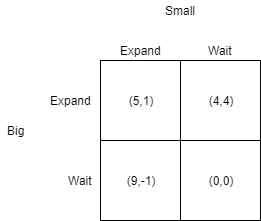Game theory is the study of mathematical models on how two entities make decisions against each other so that they are able to get the maximum benefit. This useful theory can explain a lot of phenomena in the marketing including why often small companies have difficulties expanding the market like the huge companies. Game Theory can be used to explain it.
Let’s assume theoretically, there are two companies, one is a big company A and the other one is a small company B . They both find a new product that can be introduced into the market and expand it. The product values 10 million dollars in the market, Here are three situations: 1. A, B expand, earning ratio 7:3. 2. A expands, B wait, earning ratio 6:4. 3. A waits, B expands, earning ratio 9:1. Each expansion cost 2 million dollars. Here is the diagram that shows the profit each company makes in different choices. What strategies would they make to maximize their profit?

As a matter of fact in this model, the choices are not made simultaneously. Obviously, no company wants to wait forever, someone has to expand the market to make profit. If the small company B expands the market first, it would have 1 million dollars deficit. Therefore, B must wait for A to expand the market first. This strategy is reasonble in real life because introducing a new product into the market always has a cost, and by the time the expansion is done by B, A gets most of the share from the market. Therefore, B must wait for A to expand the market so that B has time to prepare and take more market shares. As for A, A must know B will wait for it, but A does not want to wait either, otherwise they both get nothing. A will eventually develop and introduce the product to the market. Thus, (Expand, Wait) is a Nash Equilibruim.
Reference: https://www.youtube.com/watch?v=Upd1ESkn-Bo


